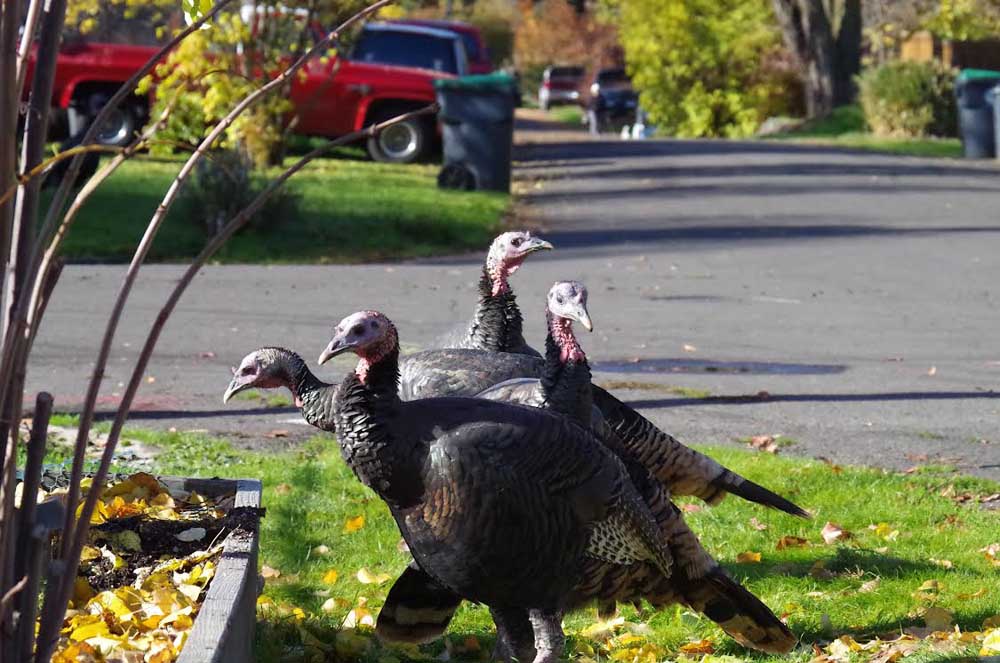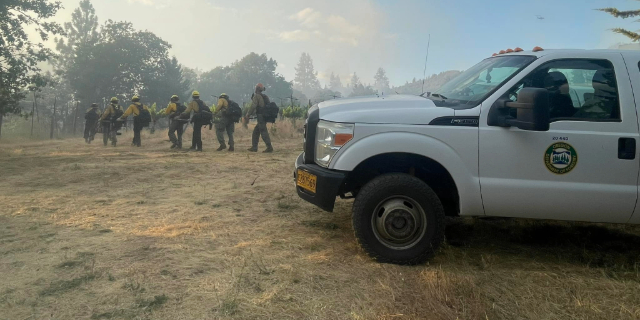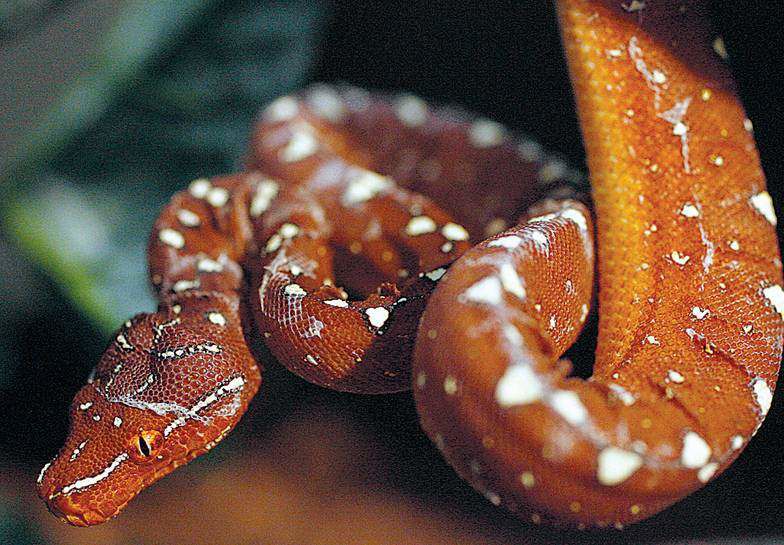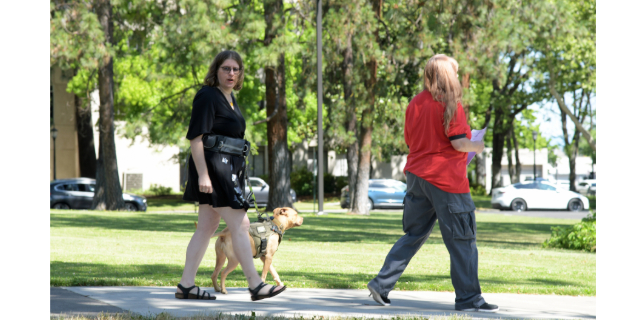Wild turkeys still strutting their stuff, to the annoyance and delight of others
Published 5:00 pm Wednesday, November 22, 2023

- Turkeys check out a garden box at Ashland and 10th streets on Monday in east Medford. They pecked away in the dirt in the box and one got up in it, where its claws could scratch at the dirt, despite a protective netting laid down on the surface of the soil.
Why did the turkey cross the road?
To annoy drivers in east Medford? To delight onlookers?
To prove he wasn’t a chicken!
In honor of Thursday’s pending day of thanks and feasting, we revisit the condition of the wild turkey in Medford, where the city seven years ago actually surveyed eastside residents after receiving complaints.
A quick trip to the near eastside on Monday was enough to quickly show that the birds are still in abundance. And a quick survey of neighborhood residents was enough to show there’s still a variety of opinions about them.
“I think they’re great,” said Jennifer Maier, who was out for a walk with her sister, Amelia, along Willamette Street north of Siskiyou Boulevard. “It’s kinda cool to see wild animals around.”
As many as 18 turkeys have visited their backyard.
“We got to watch the chicks grow up,” Maier said. “That to me is the coolest thing.”
The birds, which often cross in front of traffic, did so at least three times that morning.
“Drivers expect it,” Amelia Maier said.
Around the corner, Andrea Oshell was loading up her car at a friend’s place.
“It’s nice to have a little bit of wildlife,” she said.
However, the turkeys roost on her friend’s garage roof and poop on her friend’s vehicle. The friend’s dog barks at them, too.
Oshell said her husband took her turkey hunting once.
“He said I had to sit very still because they have excellent vision.”
She fell asleep.
She doesn’t have a problem with the turkeys slowing traffic.
“They literally rule the roost out here on the street,” she said. “It’s kinda nice to make people slow down.”
A block to the east on Ashland Avenue, 15 turkeys wandered from yard to yard, scratching away at leaves and pecking at the ground. At 10th Street, a few of them rummaged through a couple of roadside garden boxes.
Joyce Squire walked by with her dog, Skip, careful to avoid coming too close to the turkeys.
“Don’t they know they could be eaten soon?” she said. “They don’t know what’s coming.”
The birds can be destructive, she said. They scatter bark chips from her yard and into her driveway.
“They dig through that,” she said. “Kind of brazen.”
The birds strutted uphill to hang out in a shaded hillside property where David Thompson interrupted his walk to take their picture.
“They probably would be pretty tough eating,” he said. “I would imagine if you were a pilgrim, tough eating doesn’t matter much.”
“Most people, if they have contact with wild turkeys, it’ll be the beverage,” he said.
Wild Turkey is a brand of Kentucky whiskey.
Nearby, Anne and John Dennehy were outside doing yard work.
“They are cute the first 20 times you see them,” she said. “Then they’re not so cute.”
She had heard about them flaring at mail carriers and chasing schoolchildren. In her yard, they also scatter bark chips with their “sharp little claws” looking for bugs.
“This is no place for wildlife,” she said. “The city needs to decide.”
Like pedestrians, the turkeys cross the street anywhere they want, she said.
“They don’t obey laws.”
Her husband said one of his neighbors was a hunter who viewed the birds as a meal, if it ever came to that.
“These turkeys were his emergency food supply,” he said.
A mail carrier named Julia walked by.
“They don’t bother me,” she said.
But some carriers have been chased, according to her.
“Some carriers are a little terrified.”
The birds, she said, “can pick up on that vibe.”
The Humane Society of the United States says turkeys have a pecking order of dominance and may view people or pets who act fearful as underlings and will chase them or block them from homes or vehicles. Scare them away by making noises, waving your arms or dousing them with water from a hose or squirt gun, the organization states on its website.
“They are usually timid and scare easily.”
In 2016, the city got so many complaints it sent out a letter to about 100 eastside residents, including people living near East Main Street, Bundy Street, Mt. Echo Drive and Eastridge Drive. Residents were asked if they liked or disliked the turkeys. Forty-five said yes and 47 said no.
“So 45 people wanted them to be left alone and 47 people wanted them removed as a nuisance,” said Suzi Gish, city code enforcement program manager.
The city checked with the Oregon Department of Fish and Wildlife and were told that “they would not give the city a permit to remove the fowl from the city, and that [the turkeys] would most likely only come back,” according to Gish.
Instead, the city created an ordinance prohibiting the feeding of turkeys, as well as other wildlife. A secondary ordinance was created two years later prohibiting the keeping of turkeys on residential property. Other cities have similar ordinances.
In a bit of whimsy, Medford resident Michael Ahn has created a Facebook social media page named East Medford Turkeys, where people have posted pictures and videos.
“I’m all for having the wildlife around,” said Ahn, who works for the Sierra Club, an organization that works to protect wildlife and wild places.
One of the pictures he posted shows turkeys at the I.O.O.F. Eastwood Cemetery wandering near tombstones where he and his family had placed flags honoring the graves of veterans.
“Huge gaggle of turkeys paying homage to the veterans at the cemetery,” Ahn wrote, describing the photo.
He and his family live near the cemetery, 1581 Siskiyou Blvd., not far from Bear Creek Park.
“We get quite a bit of wildlife,” Ahn said in a phone interview. “We’ve been seeing them since our kids were in elementary school, junior high school.”
They watched as the birds grew from babies into adults.
“Like a whole life-cycle journey, which the kids get to see every year,” he said.
The kids are now adults, but the next generation is coming along to be delighted.
Ahn suggests that drivers be patient when encountering turkeys crossing the road. Honk your horn or drive forward slowly, or just set and enjoy the parade.
“You’ve got elk crossing signs and deer crossing signs,” he said. “Might as well have the city make some turkey crossing signs.”
• Adult males are toms and adult females are hens. Juvenile males are jakes, juvenile females are jennies, and babies are poults.
• Toms fan their tails and are larger than hens.
• Adults have 5,000 or more feathers.
• Turkeys can run 18 mph and fly up to 50 mph.
• Turkeys, which are not native to Oregon, were trapped in other states and relocated.
• Turkeys can be hunted for sport or food in Oregon under a state-issued license and tag.
• Oregon’s Wild Turkey Management Plan, updated in 2018, states, “challenges still exist for addressing and resolving turkey issues in urban and suburban areas.”
Sources: U.S. Fish & Wildlife Service; Oregon Department of Fish and Wildlife






